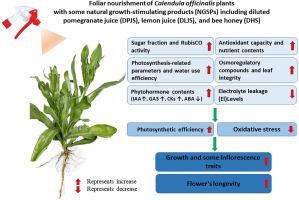As nature's allies: Bee honey outperforms pomegranate and lemon juices in improving physio-biochemistry, antioxidants, RubisCO gene expression, and vase life of Calendula officinalis
IF 4.6
Q2 MATERIALS SCIENCE, BIOMATERIALS
引用次数: 0
Abstract
Honey, pomegranate juice, and lemon juice are natural plant growth biostimulators that contain many bioactive substances that play essential roles in many plants’ physio-biochemical processes, and development. The objectives of this research were to explore how foliar spraying with a 5 % or 10 % diluted pomegranate juice solution (DPJS), a 5 % or 10 % diluted lemon juice solution (DLJS), or a 5 % or 10 % diluted honey solution (BHS), versus a control (distilled water; D-H2O), positively influenced the growth, pharmaceutical, and ornamental qualities of calendula (Calendula officinalis L.) plants in both the 2021/2022 and 2022/2023 seasons. Foliar spraying with 5 %- or 10 %-DPJS, 5 %- or 10 %-DLJS, or 5 %- or 10 %-BHS significantly increased photosynthesis-related assessments (total chlorophyll and carotenoid contents, the maximum quantum efficiency of photosystem II (Fv/Fm), and net CO2 assimilation), water use efficiency, RubisCO content and activity, RubisCO gene expression, and sugar fraction (glucose, sucrose, and starch contents). Also, osmoregulatory compounds (K+, total soluble sugars, and glycine betaine contents), antioxidant capacity (in terms of total flavonoid, anthocyanin, proline, ascorbate, and glutathione contents), nutrient and hormonal contents were significantly increased by foliar spraying of all the above-mentioned treatments. These positive findings were noticeably reflected in improved growth (fresh and dry plant weights), inflorescence traits (number of inflorescences on plant, fresh and dry petal weights, petal content of soluble sugars, ß-carotene, and total carotenoids), and longevity of inflorescence (vase life and water uptake by inflorescences), while electrolyte leakage and abscisic acid were noticeably decreased compared to foliar spraying with D-H2O. The second-best treatment was 5 %-DPJS or 10 %-BHS, and they were preceded by 5 %-BHS as the best treatment, which the research results recommended applying in the field to obtain the best pharmaceutical and ornamental qualities of calendula.

作为大自然的盟友:在改善金盏花的生理生化、抗氧化剂、RubisCO 基因表达和花瓶寿命方面,蜂蜂蜜优于石榴汁和柠檬汁
蜂蜜、石榴汁和柠檬汁是天然的植物生长生物刺激剂,含有多种生物活性物质,在许多植物的生理生化过程和生长发育中发挥着重要作用。本研究的目的是探讨在 2021/2022 和 2022/2023 两个季节,叶面喷洒 5 % 或 10 % 的稀释石榴汁液(DPJS)、5 % 或 10 % 的稀释柠檬汁液(DLJS)或 5 % 或 10 % 的稀释蜂蜜溶液(BHS)与对照组(蒸馏水;D-H2O)相比,如何对金盏花(Calendula officinalis L.)植物的生长、药效和观赏性产生积极影响。叶面喷洒 5 %- 或 10 %-DPJS、5 %- 或 10 %-DLJS,或 5 %- 或 10 %-BHS,可显著提高光合作用相关评估(总叶绿素和类胡萝卜素含量、光系统 II 的最大量子效率(Fv/Fm)和二氧化碳净同化)、水分利用效率、RubisCO 含量和活性、RubisCO 基因表达和糖分(葡萄糖、蔗糖和淀粉含量)。此外,叶面喷洒上述所有处理后,渗透调节化合物(K+、总可溶性糖和甘氨酸甜菜碱含量)、抗氧化能力(总黄酮、花青素、脯氨酸、抗坏血酸和谷胱甘肽含量)、养分和激素含量均显著增加。与叶面喷施 D-H2O 相比,电解质渗漏和赤霉酸含量明显减少。次优处理为 5 %-DPJS 或 10 %-BHS,在它们之前的最佳处理为 5 %-BHS,研究结果建议在田间应用这些处理,以获得金盏花的最佳药用和观赏品质。
本文章由计算机程序翻译,如有差异,请以英文原文为准。
求助全文
约1分钟内获得全文
求助全文

 求助内容:
求助内容: 应助结果提醒方式:
应助结果提醒方式:


